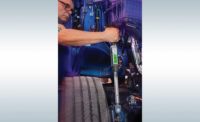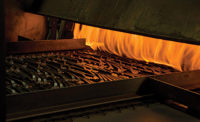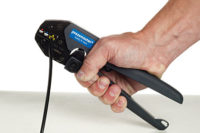Today’s pneumatic and electric fastening tools are more powerful and accurate than ever. But, that doesn’t obviate the need to check the joint with a manual torque wrench or screwdriver, even if it’s just occasionally for auditing.
Manual torque tools provide a low cost, accurate, long-lasting alternative to pneumatic or electric equipment. And, the tools are not affected by air pressure fluctuations or power outages.
“It is very common for a manual tool to be present next to a pneumatic or electric tool in case it fails,” says Andrew Kuby, senior service technician at Tohnichi America Corp. “This way, the assembly line can continue to function without a costly shutdown.
“In addition, these tools can often fit in spaces too small for a powered product,” adds Kuby. “They do not require batteries or compressors, and they don’t have even a fraction of the moving parts of a powered tool. This means manual tools require less frequent maintenance, and usually at a much lower cost.”
According to Kuby, manual torque tools are durable, portable and easy to repurpose when line requirements change. They also don’t require an engineering degree or extensive training to repair or maintain.
“Manual torque wrenches and screwdrivers offer both large and small manufacturers the opportunity to apply dynamic torque to assemblies and audit the same assemblies statically with potentially the same tool,” notes Tim Haper, regional sales manager at ASG, division of Jergens Inc.
Manual tools are considered static (application by hand) torque devices. Application of static torque is typically more accurate than torque applied by a dynamic device (motor-driven tool). They are available in adjustable (with a scale) or preset (set at one value) models, which allows them to serve different applications.
“With manual torque screwdrivers, there are two general options,” says Brad Mountz, president and CEO of Mountz Inc. “The type of fastening application tends to dictate which tool is best suited for it.
“Preset torque screwdrivers are typically used for production applications where there is one torque setting required and you need to prevent incidental torque adjustment or the operator tampering with the torque setting,” explains Mountz. “Adjustable torque screwdrivers offer different setting options for various torque applications that require more than one torque value.”
Today, manual torque tools are more important than ever. “Material is becoming more complex,” says Mountz. “For instance, carbon-fiber composites and ceramics [are more popular]. And, manual tools typically go down to much lower torque than a powered tool.”
“Manual torque tools were the original quality check,” adds Haper. “Even though we really want clamp load, there is a relationship between torque and clamp load. Manual torque tools provide this function with accuracy, repeatability, and in some cases, frugality.
“In the beginning, there were beam wrenches,” Haper points out. “We have progressed through click, dial and digital wrenches. Today, we use the same types of wrenches to maintain line control and collect data. Manual torque tools have risen to the expectations of assemblers in terms of technology and networking.”
No matter how much materials and other factors change, some things stay the same. “The trend has always been and always will be error proofing,” says Tohnichi’s Kuby. “Making sure the fastener you have just tightened is exactly to the specification for the product is the highest priority.
“We are also seeing more demand for wrenches and screwdrivers with over-torque prevention built in,” adds Kuby. “This prevents an operator from applying more torque than required if they are inexperienced, tired, distracted or holding the tool in an unusual position.
“Lately, it is becoming more important to store the tightening data,” explains Kuby. “This protects manufacturers from liability claims once the product leaves the [plant floor]. If you can prove a fastener was tightened properly at the factory, you can eliminate this as a cause of failure. Stored data can also help identify trends or places where the manufacturing method can be improved.”
In the past, most manual torque tools were isolated and confined to benchtop use. “But, today, they can be integrated with a lot more feedback devices,” says John Vargas, director of sales at Futek Advanced Sensor Technology Inc. “Data output can now be sent to many different forms of digital instrumentation. There are more data options than ever, and more ways to read and interpret that data.”
Myths and Misperceptions
Some engineers believe that manual torque tools are old fashioned and no longer used much in production environments. They argue that they are slower than cordless power tools and not as reliable or accurate as DC electric tools.
“Nothing could be further from the truth,” claims Kuby. “Every major automotive manufacturer in the world uses manual torque equipment in some capacity. Manual torque tools are used [to produce everything] from wind turbines and electronic components to aircraft and spacecraft. They are also used extensively for prototyping and testing of new products to improve the reliability, durability and quality of the final product.
“Manual torque equipment has been around a long time and will continue to be an essential part of assembly and manufacturing far into the future,” predicts Kuby.
“Japanese carmakers will often use an ergonomic power tool to run down a fastener, followed by final torque with a manual torque tool,” notes Mountz. “To me, this justifies or proves the accuracy of a hand torque tool.”
Some engineers also have misperceptions about how torque wrenches and screwdrivers affect joint designs.
“The idea that the accuracy of a torque wrench will change from a soft joint to a hard joint is somewhat incorrect,” says Don Reynertson, vice president of sales at Sturtevant Richmont, which traces its roots to a deflecting beam wrench invented and patented by Walter Chrysler almost 100 years ago. “In fact, the torque wrench was the first torque tool invented where accuracy is totally unaffected by the condition of the joint.
“A pneumatic tool will be affected by a soft joint because it takes longer to pull the pieces together,” explains Reynertson. “If you are fastening a manifold onto an assembly and it has eight fasteners, the first two or three fasteners will take longer using a pneumatic wrench because the run-down time is longer. Pneumatic tools run on two factors: run time and air pressure.”
Another big misconception about manual torque tools is that training is less important. “Manual tools by definition are operator-dependent,” says ASG’s Haper. “To achieve a good fastening, the operator needs training. But, some untrained operators might think that applying a few extra degrees of turn might be better.
“Similarly, the operator might not apply the force slowly or evenly,” notes Haper. “Another example is when an assembler uses a power tool to start the fastener and finishes with a click wrench. Imagine the consequences if the power tool exceeds the target torque, the manual wrench clicks, but the fastener is over-torqued.”






